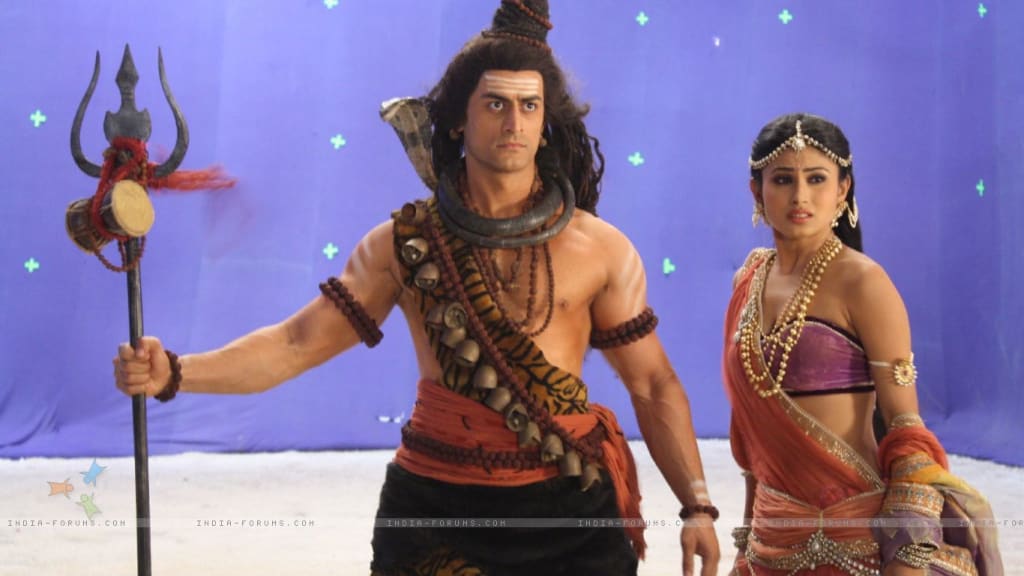
This article is about the previous birth of the goddess Parvati. For other uses, see Sati (disambiguation). For the Egyptian goddess, see Satis (goddess).
"Dakshayani" redirects here. For other uses, see Dakshayani (disambiguation).Sati (/ˈsʌtiː/, Sanskrit: सती, IAST: Satī, lit. 'truthful' or 'virtuous'), also known as Dakshayani (Sanskrit: दाक्षायणी, IAST: Dākṣāyaṇī, lit. 'daughter of Daksha'), is the Hindu goddess of marital felicity and longevity, and is worshipped as an aspect of the mother goddess Shakti. She is generally considered the first wife of Shiva, the other being Parvati, who was Sati's reincarnation after her death.
The earliest mentions of Sati are found in the time of the Ramayana and the Mahabharata, but details of her story appear in the Puranas. Legends describe Sati as the favourite child of Daksha but she married Shiva against her father's wishes. After Daksha humiliated her, Sati killed herself to protest against him, and uphold the honour of her husband.[1] In Hinduism, both Sati and Parvati, successively play the role of bringing Shiva away from ascetic isolation into creative participation with the world.[2]
Sati's story plays an important part in shaping the traditions of two of the most prominent sects of Hinduism — Shaivism and Shaktism. It is believed that parts of Sati's corpse fell on fifty-one places and formed the Shakti Peethas. The historical act of Sati, in which a Hindu widow self-immolates on her husband's pyre, is named and patterned after this goddess, though she is not the origin of it. MARRIAGE .......Sati is believed to be very beautiful but the legends mention her penance and devotion, which won the heart of the ascetic Shiva.[26][27] According to the legend, Sati left the luxuries of her father's palace and retired to a forest to devote herself to austerities of a hermetic life and the worship of Shiva. She was often tested by Shiva or his attendants. Finally, Shiva acceded to her wishes and consented to make her his bride. Despite Daksha's unwillingness, the wedding was held in due course with Brahma serving as the priest. Sati made her home with Shiva in Kailash.[26] Tension between Shiva and Daksha further arises when, Daksha starts to dislike Shiva because of his odd appearance and behaviour.[2][28]
Some texts diverge, however. According to the version found in Mahabhagvata Purana, Daksha arranged Sati's Swayamvar (self-choice ceremony), where all except Shiva were invited. When Sati couldn't find Shiva, she threw a garland in the air to choose her husband. Shiva manifested there and it fell on him, thus they were married.[21] In the 18th century Svathani Katha, when Shiva asked Sati's hand in marriage, Daksha refused, claiming him unsuitable. Vishnu aided Shiva by disguising him as a sanyasi and had him marry her.[note 3][28] While many versions mention Daksha's objections to the marriage, the Shiva Purana doesn't mention any harsh opposition, though he starts to develop a deep hatred after the wedding.[28] Formation of the Shakti Peethas
Another important legend associated with Sati is the formation of the Shakti Peetha. Shakti Peethas are shrines or divine places of the Mother Goddess, believed to have enshrined with the presence of Shakti due to the falling of body parts of the corpse of Sati. It is believed that an enraged Shiva performed the Tandava dance with Sati's charred body, which led her body to come apart and the pieces fell at different places on earth.[42][43] In a more detailed narration found in some texts, Shiva, crazed with grief, roamed with Sati's corpse throughout the universe, causing universal imbalance. The divinities called upon the god Vishnu to restore Shiva to normalcy and calm. Vishnu used his Sudarshana Chakra (discus weapon) to dismember Sati's cadaver, following which Shiva regained his equanimity.[2]
The legend ends with Sati's body being dismembered into many pieces which fell on earth at various places. Several different listings of these holy places, known as Shakti Peethas, are available; some of these places have become major centres of pilgrimage as they are held by the Goddess-oriented Shakta sect to be particularly holy. Besides main Shakti Peethas, some small peethas like Bindudham came into existence which are due to Sati's fallen blood drops.
About the Creator
MANISH KUMAR
HARD WORK IS SUCCESS






Comments
There are no comments for this story
Be the first to respond and start the conversation.